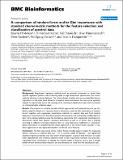A comparison of random forest and its Gini importance with standard chemometric methods for the feature selection and classification of spectral data
Author(s)
Menze, Bjoern Holger; Kelm, Bernd Michael; Masuch, Ralf; Himmerlreich, Uwe; Bachert, Peter; Petrich, Wolfgang; Hamprecht, Fred A.; ... Show more Show less
DownloadMenze-2009-A comparison of rand.pdf (1.198Mb)
PUBLISHER_CC
Publisher with Creative Commons License
Creative Commons Attribution
Terms of use
Metadata
Show full item recordAbstract
Background
Regularized regression methods such as principal component or partial least squares regression perform well in learning tasks on high dimensional spectral data, but cannot explicitly eliminate irrelevant features. The random forest classifier with its associated Gini feature importance, on the other hand, allows for an explicit feature elimination, but may not be optimally adapted to spectral data due to the topology of its constituent classification trees which are based on orthogonal splits in feature space.
Results
We propose to combine the best of both approaches, and evaluated the joint use of a feature selection based on a recursive feature elimination using the Gini importance of random forests' together with regularized classification methods on spectral data sets from medical diagnostics, chemotaxonomy, biomedical analytics, food science, and synthetically modified spectral data. Here, a feature selection using the Gini feature importance with a regularized classification by discriminant partial least squares regression performed as well as or better than a filtering according to different univariate statistical tests, or using regression coefficients in a backward feature elimination. It outperformed the direct application of the random forest classifier, or the direct application of the regularized classifiers on the full set of features.
Conclusion
The Gini importance of the random forest provided superior means for measuring feature relevance on spectral data, but – on an optimal subset of features – the regularized classifiers might be preferable over the random forest classifier, in spite of their limitation to model linear dependencies only. A feature selection based on Gini importance, however, may precede a regularized linear classification to identify this optimal subset of features, and to earn a double benefit of both dimensionality reduction and the elimination of noise from the classification task.
Date issued
2009-07Department
Massachusetts Institute of Technology. Computer Science and Artificial Intelligence LaboratoryJournal
BMC Bioinformatics
Publisher
BioMed Central Ltd.
Citation
Menze, Bjoern et al. “A comparison of random forest and its Gini importance with standard chemometric methods for the feature selection and classification of spectral data.” BMC Bioinformatics 10.1 (2009): 213.
Version: Final published version
ISSN
1471-2105